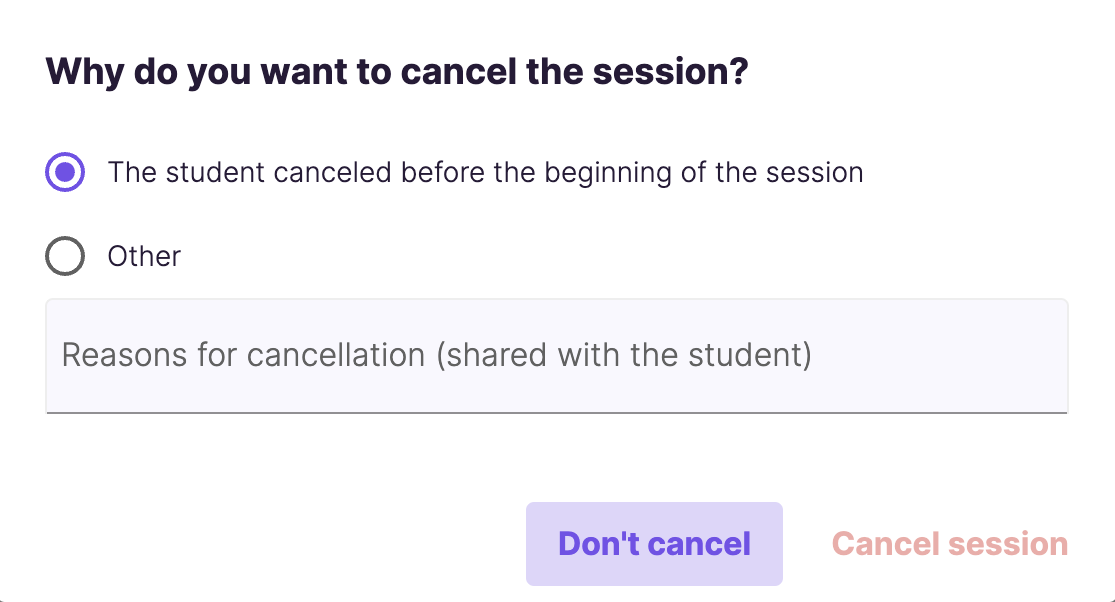In this chapter, we look at how to organize and run a mentoring session in a constructive and effective way.
Okay, but what if my student has a problem and the session has to be canceled?
Good question! Let’s take a quick look at the procedure for canceling a session.
What if the student doesn’t notify me in advance and just doesn’t show up to the session?
This is another special situation you might encounter. In this case, we suggest you indicate that the student was absent: cancel the session and select the reason shown below:

Now that you know what to do when a mentoring session is canceled, let’s look at how to organize a session from A to Z when your student does make it. ☺️
Start the Session by Making Conversation
Check in on your student: How are they doing? How do they feel today?
Depending on the student and their level of progress, you might spend more time (5-10 minutes) discussing their level of motivation, their personal life, any issues they might have.
Aside from checking in on the student’s skill level and understanding of content, this time gives you a chance to identify whether there are any other external factors that could make learning difficult.
Ask the Student About Their Progress
At the end of the last session, you will have set several goals together for this session. Now it’s important to look at how much progress they made and encourage them to reflect on their work, with questions like the following:
What have you learned this week?
Are there any areas that you’re struggling with?
What do you need to be able to move forward?
Which goals did you reach?
What kind of difficulties did you have for the goals that you didn’t reach yet?
Do we need to revise the goals to be more attainable? Do they need to be more detailed? Do they need to be reworded or broken down?
Depending on their progress and the answers your student gives you, continue to build their personalized learning strategy with them.
Help Your Student to Move Forward in Their Project
Your student may run into difficulties. Whether the problem is related to their understanding of a method or inexperience using a tool, you can:
Do exercises from a course again together (or encourage them to take the course if they haven’t already).
Direct them to other external resources, e.g. YouTube tutorials or blog posts.
Give them a practical demonstration with a real example.
When you do a demonstration, we recommend taking screenshots or recording this part of the session so that the student can look at it again later and copy the steps.
That said, remember to congratulate your student each time they submit work and make progress (even if there is a delay). Above all, encourage them! The learning journey can be a long one, which requires perseverance but also support, whatever the student’s knowledge level or their particular difficulties.
Set Goals for the Next Session
At the end of the session, set new goals for the student to reach!
This student must take part in the setting of goals with you:
What will they be able to do for next week?
How will they do it? What do they need to move forward?
Now’s the perfect time to find out what valuable advice Joy and Mike can give us about running a mentoring session:
After listening to Joy and Mike, do you have any more questions, or would you like some more resources to look at? No problem. You can explore the different Help Center articles on that subject.
Let’s Recap!
We recommend structuring your mentoring sessions for the most effective learning.
Catch up with your student’s news: it’s an important part of the session. Even a brief conversation helps you to build a good relationship that favors teamwork and progress.
Help your student when they’re stuck and find ways to overcome challenges they encounter on their project.
Get your student involved in setting goals for each session.
To help your student work independently between sessions, make use of a valuable tool: the session report. Find out how to use it in the next chapter.
